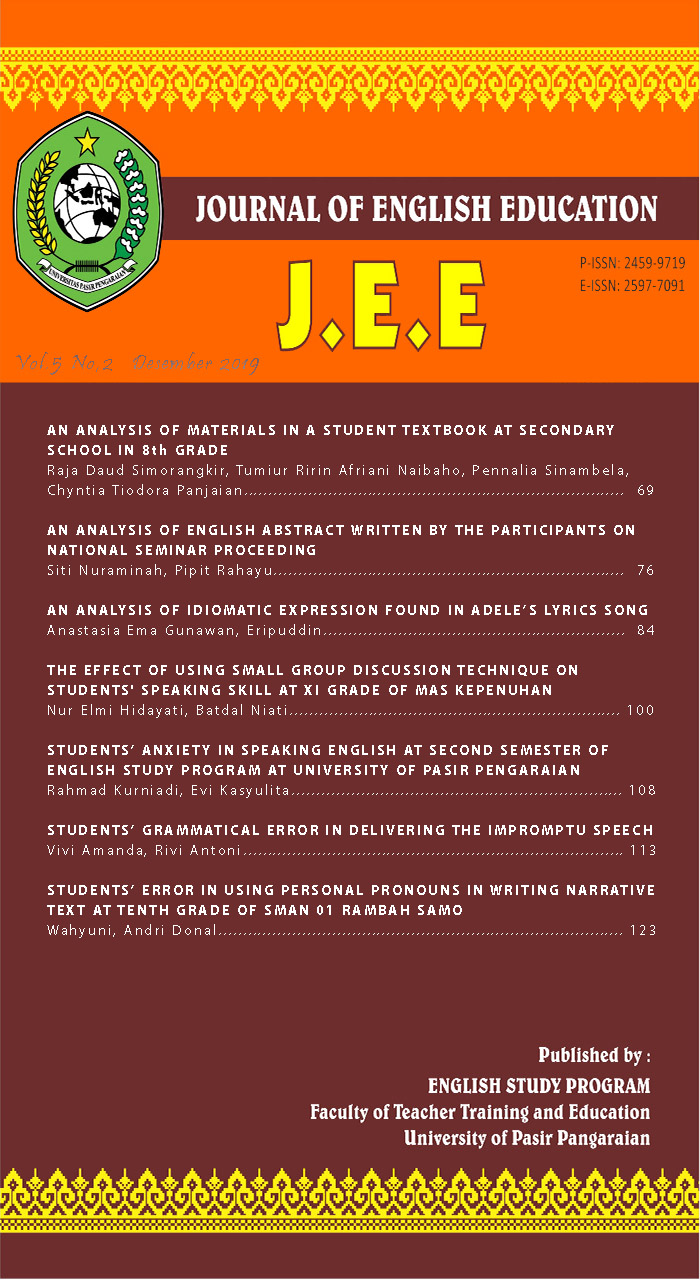STUDENTS’ ERROR IN USING PERSONAL PRONOUNS IN WRITING NARRATIVE TEXT AT TENTH GRADE OF SMAN 01 RAMBAH SAMO
Keywords:
Error Analysis, Personal Pronouns, Writing, Narrative Text.Abstract
The purpose of this research was to find out the types of students’ error in using personal pronouns in writing narrative text. The indicators are: (1) Omission, (2) Addition, (3) Selection, (4) Ordering. By those indicators, the researcher would know the kinds of error that made by the students in using personal pronouns in writing narrative text. This was a qualitative descriptive study. The population was tenth grade students of SMAN 1 Rambah Samo. The samples were 29 student, that taken by using random sampling technique. The instrument was writing test. From the finding of the study, it can be seen in the high frequency error was made by students was error of selection with 75 errors, which means 60 % of error total. The next most error made by the students was error of ordering with 23 errors or 19 %. The students made 20 errors of error of omission or 16 %. They also made 6 errors of addition or 5 %. As a result, it can be concluded that the students still have problem in using personal pronouns in writing narrative text.References
Amin, Aras Abdalkarim. (2017). The Frequency of Morpho-Syntactic Errors by Kurdish EFL Learners. IOSR Journal of Humanities and Social Science (IOSR-JHSS).Volume 22, Issue 3, Ver. V, March 2017.e- ISSN: 2279-0837, p- ISSN:2279-0845. www.iosjournals.org. Retrieved October 16th 2018.
Antoni, Rivi. 2016. Writing Task Activities in Developing Students’ Writing Skill. Jurnal Ilmiah Edu Research Vol. 5 No. 1 Juni 2016. Retrieved June 25th 2019.
Bogdan, R. C and Biklen, S. K. (2007). Qualitative Research For Education an Introduction To Theory and Methods. Boston: Pearson.
Brown, H. D. (2000). Principles of Language Learning and Teaching. New york: Longman.
Corder, S. P. (1981). Error Analysis and Inter- language. London: Oxford University Press
Donal, Andri. (2015). Exploring Students’ Errors in Constructing Sentences. Journal of English Education Vol. 1 No.2. ISSN: 2459-9719. 22nd January 2019
Ellis, R and Barkhizen, G. (2005). Analysis Learner Language. Oxford: Oxford University Press.
Fakeye. Bosede and D.O. (2016). Instruction in Text-Structures as A Determinant of Senior Secondary School Students’ Achievement in English Narrative Text in Ido Local Goverment Area, Oyo State. International Journal of Arts and Humanities (IJAH) Bahir Dar-Ethiopia. Vol. 5 (2), S/No 17. ISSN: 2225-8590. Retrieved January 21st 2019
Harmer, Jeremy. (2007). How to Teach Writing. Newyork: Longman
Jabeen, Aqsa. (2015). The Role of Error Analysis in Teaching and Learning of Second and Foreign Language. Education and Linguistics Research. ISSN 2377- 1356.2015, Vol. 1, No. 2. URL: http://dx.doi.org/10.5296/elr.v1i1.8189. Retrieved January 05th
Phuket, P.R.N. And Normah, B. O. (2015). Understanding EFL Students’ Error in Writing. Journal of Education and Practice. Vol.6, No.32. ISSN 2222-1735 (Paper) ISSN 2222-288X (Online). www.iiste.org. Retrieved January 25th 2019
Swick, Ed. (2009). Practice Make Perfect English Sentence Builder. New York: Mc Graw Hill
Zumakhsin and M, Yulia. (2013). Progress A Contextual Approach to Learning English An English Textbook for Senior High School. Jakarta: Ganeca.




